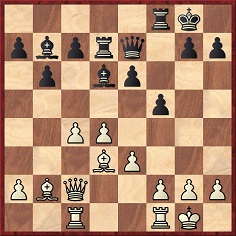Chess Notes
Edward Winter
When contacting us by e-mail, correspondents are asked to include their name and full postal address and, when providing information, to quote exact book and magazine sources. The word ‘chess’ needs to appear in the subject-line or in the message itself.
| First column | << previous | Archives [175] | next >> | Current column |
11207. Double bishop sacrifice (C.N. 2673)
Firstly, the full text of C.N. 2673 is reproduced, from 2002:
When was the first known instance of the double bishop sacrifice? Not Lasker v Bauer, Amsterdam, 1889, but a game played five years earlier:
Amos Burn – John Owen
Liverpool, 7 February 1884
Irregular Opening1 Nf3 e6 2 d4 b6 3 e3 Bb7 4 b3 Nf6 5 Bb2 d5 6 Nbd2 Bd6 7 Bd3 O-O 8 c4 Nbd7 9 Rc1 Qe7 10 O-O Ne4 11 Qc2 f5 12 Ne5 Nxd2 13 Qxd2 Rad8 14 Nxd7 Rxd7 15 Qc2 dxc4 16 bxc4
16…Bxh2+ 17 Kxh2 Qh4+ 18 Kg1 Bxg2 19 f3 Bxf1 20 Bxf1 Rf6 21 Bg2 Rh6 22 d5 exd5 23 Qxf5 Qe7 24 Bd4 c5 25 Be5 dxc4 26 Rxc4 Qd8 27 Rg4 Rf7 28 Qc2 Rh5 29 f4 Kf8 30 Bf1 Rd7 31 Qc3 g6 32 Bf6 Qc8 33 Bg5 Rg7 34 Rg2 Qd7 35 Bc4 b5 36 Qf6+ Ke8 37 Qe5+ Kf8 38 Qb8+ Qe8 39 Qd6+ Re7 40 Qf6+ Resigns.
Source: notebooks of the Liverpool Chess Club.
This important discovery was made by Richard Forster, who published the game in an article on Burn on pages 12-13 of the July 2001 CHESS.
Specifying sources is not only an act of fairness to earlier writers but also a way of ensuring that relevant background information is known. In this instance, the source ‘notebooks of the Liverpool Chess Club’ diminishes the possibility that Lasker was aware of the Burn v Owen game before he played the double bishop sacrifice against J.H. Bauer (Amsterdam, 1889).
See too pages 185-186 of Amos Burn A Chess Biography by Richard Forster (Jefferson, 2004). On the theme of the double bishop sacrifice, a footnote on page 185 had a late addition:
‘However, in the BCM, December 2003, page 666, O. Hindle draws attention to an even earlier specimen by Cecil De Vere from The Field, 14 September 1867 [page 225].’
Detailed coverage of the double bishop sacrifice on the basis of Lasker v Bauer is on pages 368-376 of Emanuel Lasker edited by R. Forster, M. Negele and R. Tischbierek (Berlin, 2018).
Below (with scans kindly provided by the Cleveland Public Library) are two short, little-known games with the same motif. The first comes from pages 167-168 of the South African Chess Magazine, July 1935:
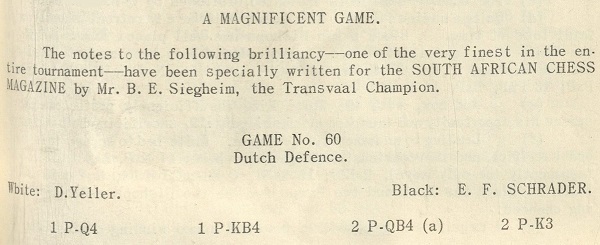
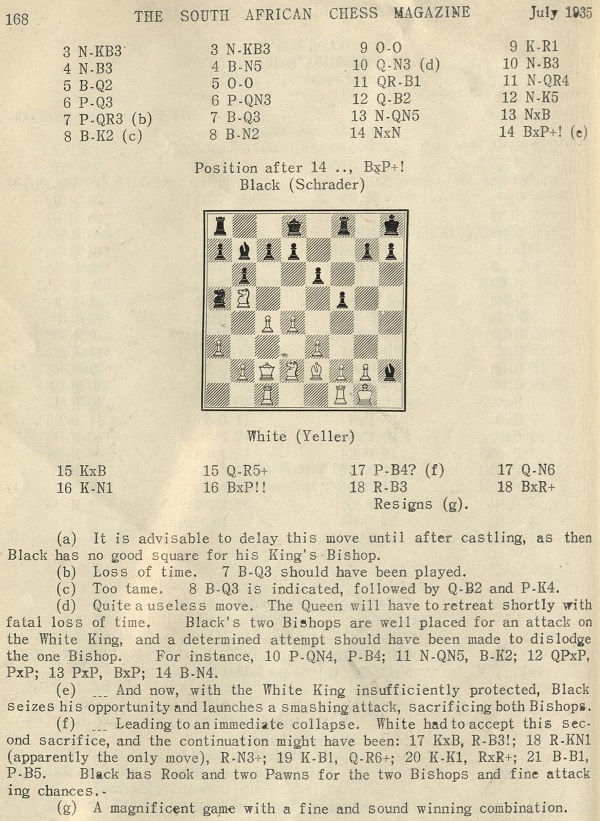
1 d4 f5 2 c4 e6 3 Nf3 Nf6 4 Nc3 Bb4 5 Bd2 O-O 6 e3 b6 7 a3 Bd6 8 Be2 Bb7 9 O-O Kh8 10 Qb3 Nc6 11 Rac1 Na5 12 Qc2 Ne4 13 Nb5 Nxd2 14 Nxd2
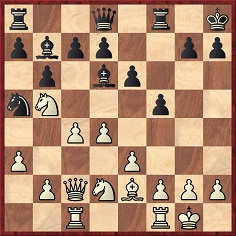
14...Bxh2+ 15 Kxh2 Qh4+ 16 Kg1 Bxg2 17 f4 Qg3 18 Rf3 Bxf3 19 White resigns.
This game between David Yeller and Edward F. Schrader in the 12th South African Championship, Johannesburg, 1935 is on page 146 of A History of Chess in South Africa by Leonard R. Reitstein (Kenilworth, 2003). Both players are in a group photograph on page 144.
The moves 18 Rf3 Bxf3 were omitted when the game was published on page 310 of the Australasian Chess Review, 14 November 1935:
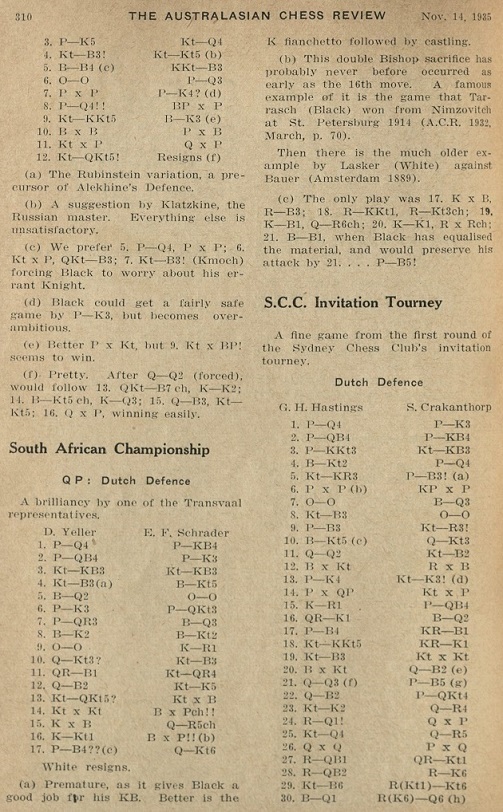
There was a follow-up item about the double bishop sacrifice on page 340 of the 7 December 1935 issue of the Australasian Chess Review:
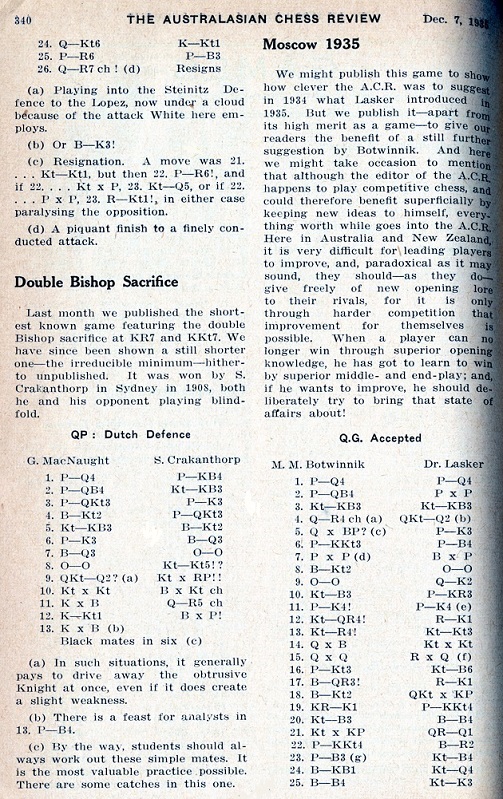
1 d4 f5 2 c4 Nf6 3 b3 e6 4 Bb2 b6 5 Nf3 Bb7 6 e3 Bd6 7 Bd3 O-O 8 O-O Ng4 9 Nbd2 Nxh2 10 Nxh2
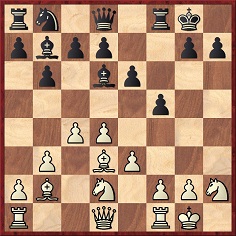
10...Bxh2+ 11 Kxh2 Qh4+ 12 Kg1 Bxg2 13 Kxg2 and ‘Black mates in six’ [sic].
That blindfold game between G. MacNaught and S. Crakanthorp was published again on page 219 of the 13 August 1936 edition of the Australasian Chess Review. The fact that the black king’s bishop was not sacrificed was still left unmentioned, and the handling of the conclusion (‘Black announced mate in four’) was still imprecise.

Can the game-score be found in a 1908 publication?
11208. Rude book reviews
Further to the discussion of this topic on pages 390-391 of A Chess Omnibus and in C.N.s 7575 and 9376, below is one of several barbs by Ed Edmondson when reviewing R.G. Wade’s Soviet Chess (London, 1968) on page 108 of Chess Life, March 1969:
‘Not recommended if your budget for chess books is at all limited. It’s one man’s opinion, but I consider this volume to be only for those who can truly afford to satisfy their own curiosity about its dullness or to acquire a collection of chess books regardless of quality.’
Another man’s opinion was on pages 58-59 of the February 1969 BCM, where one of the greatest of all chess book reviewers, W.H. Cozens, expressed some criticism of Soviet Chess but also praised it highly, concluding:
‘It would be hard to suggest how any serious student of chess could find a better use for two guineas.’
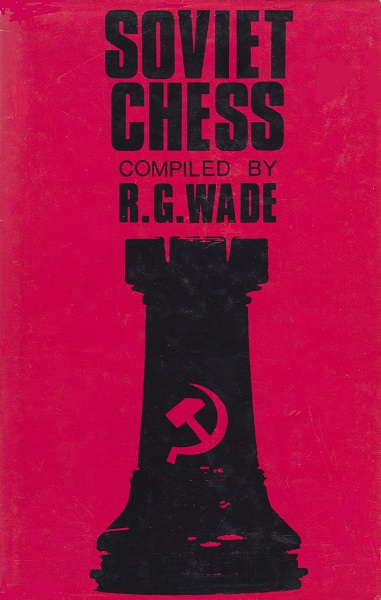
A brief notice of another book by Wade comes to mind, from the inside front cover of CHESS, mid-January 1964:
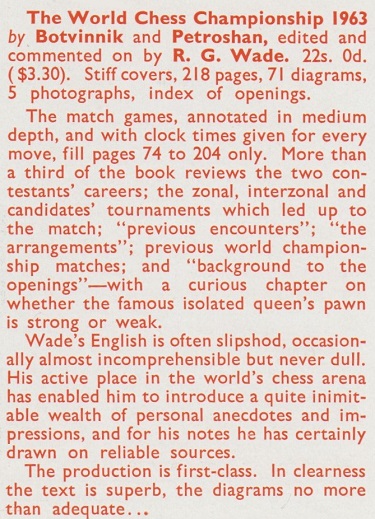
11209. ‘Known on the Continent as ...’ (C.N. 10173)
C.N. 10173 quoted six unsubstantiated assertions that ‘the little Steinitz’ was H.E. Atkins’ nickname ‘on the Continent’. A seventh instance is in an article about Atkins by Harry Golombek on page 70 of Chess Treasury of the Air by Terence Tiller (Harmondsworth, 1966).
11210. Bent Larsen and 1 b3 (C.N. 10828)
‘I do not especially recommend this opening.’
So wrote Bent Larsen about 1 b3 on page 138 of Chess Life, April 1969, in an article which has an early appearance of the name ‘Baby Orang-Utan’:
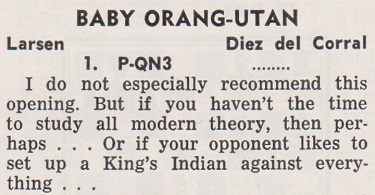
11211. Double bishop sacrifice (C.N.s 2673 & 11207)
The game (remove Black’s knight at g8) between an amateur and Cecil De Vere, London, 1867 which was mentioned in C.N. 11207: 1 e4 d5 2 exd5 e6 3 dxe6 Bxe6 4 Nf3 Bd6 5 Be2 Nc6 6 Bb5 Bd7 7 O-O O-O 8 Bxc6 Bxc6 9 d3 Re8 10 c3 Re6 11 Nd4
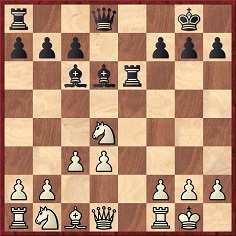
11...Bxh2+ 12 Kxh2 Qh4+ 13 Kg1 Bxg2 14 Kxg2 Rg6+ 15 Kf3 Re8 16 Rg1 Rf6+ and mates in three moves.
As noted in C.N. 11207, the game was found by Owen Hindle in The Field, 14 September 1867 and given on page 666 of the December 2003 BCM (in the Quotes and Queries column conducted by Chris Ravilious). It was discovered after publication of the monograph on De Vere, “The English Morphy?” by Owen Hindle and Bob Jones (Exmouth, 2001).
Fabrizio Zavatarelli (Milan, Italy) points out a passage on page 16 of Why Lasker Matters by Andrew Soltis (London, 2005), in the game Lasker v Bauer, Amsterdam, 1889:
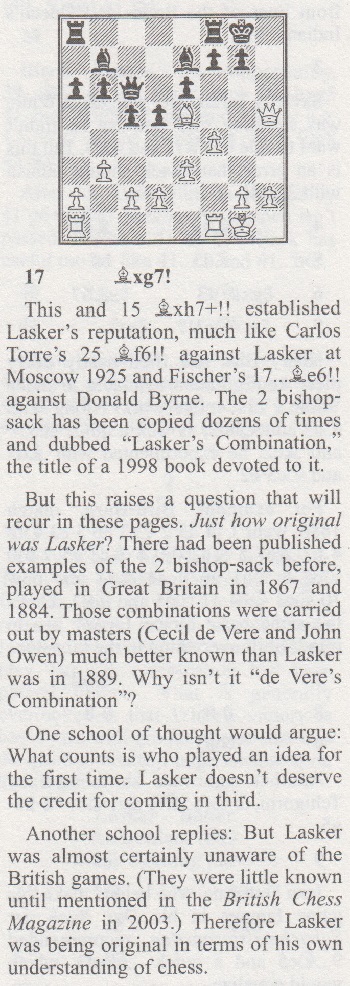
C.N. 11207 commented: ‘Specifying sources is not only an act of fairness to earlier writers but also a way of ensuring that relevant background information is known.’ Soltis did not name the researchers who found the 1867 and 1884 games (Owen Hindle and Richard Forster respectively) or, indeed, the author of Lasker’s Combination (Victor Charushin). The assertion by Soltis that the Burn v Owen game was ‘little known until mentioned in the British Chess Magazine in 2003’ is incorrect (see C.N. 11207).
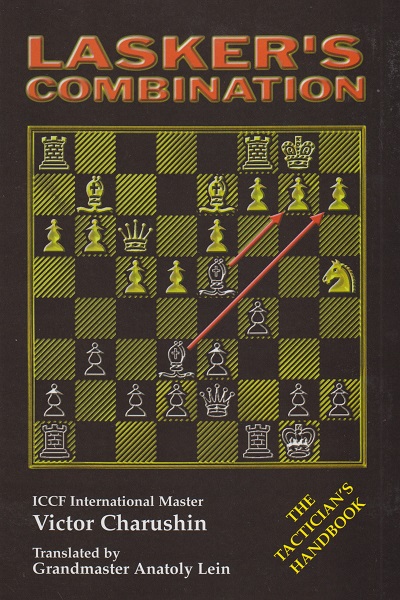
In the above position Lasker, against Bauer, played 15 Bxh7+, and Steinitz wrote on page 268 of the September 1889 International Chess Magazine:
‘The beginning of a most profound and elegant combination.’
Page 354 of the September 1889 BCM had Lasker as the loser:
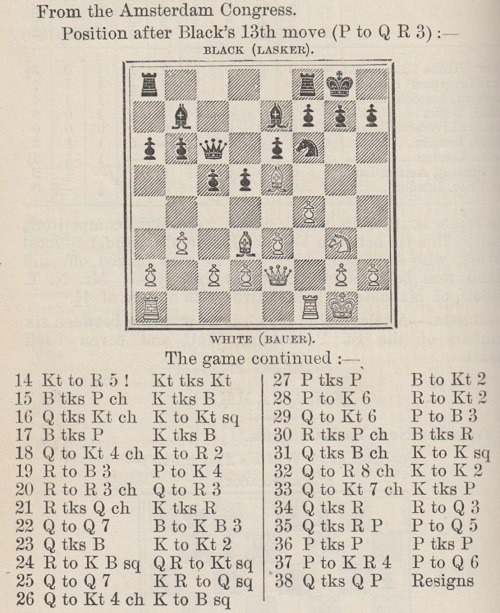
11212. Norman Tweed Whitaker (C.N. 11184)
John Hilbert (Amherst, NY, USA) writes:
‘After Whitaker’s death at 85 by stroke on 20 May 1975 at Cobb Memorial Hospital, Phenix City, Alabama, his friend and executor James E. Gates struggled to reconcile the late chessplayer’s finances. Ultimately, Whitaker’s assets did not quite satisfy his debts, and so he died a pauper. His death was largely ignored by the world, including the chess world, with one notable exception. The August 1975 Chess Life & Review obituary, written by Gates, as mentioned in C.N. 11184, avoided discussion of Whitaker’s life outside the game, and for good reason. His convictions for interstate auto theft (1924), conspiracy to defraud, along with Gaston B. Means, related to their hoax to swindle the owner of the Hope Diamond during the uproar of the Lindbergh baby kidnapping (1932), another auto theft (1932), sending narcotics through the mail (1944) and child molestation (1950) led to his spending time in Leavenworth and Alcatraz, along with a dreary host of lesser-known prisons and jails.
His papers, as I relate in detail in Shady Side: The Life and Crimes of Norman Tweed Whitaker, Chess Master (Yorklyn, 2000), reveal his near-obsessive focus on a variety of other cons, ranging from ignoring parking tickets and failing to return hundreds of library books, to skipping out on debts, cheating friends and fiancées, and attempting extortion. Some of his actions were ludicrous, some quite petty, but many of them were disturbingly disclosing of an intelligent, amoral mind which, by almost any definition, uncovers a psychopath. Although he lost his law license after his first conviction, he never lost his gusto for suing, or threatening to sue, anyone and everyone on the flimsiest contortions of facts, including the USCF. His International Master’s title, awarded by FIDE in 1965, was as much a testimony to his years of pestering the officials involved as it was to his long-gone chess strength.
And yet especially during the roughly 20 years between 1910 and 1930, when not in prison, Whitaker excelled at playing chess. What he might have accomplished in the game, had he spent his time studying and playing it, instead of hatching one failed criminal plan and contentious lawsuit after another, can never be known. To borrow a few lines written regarding his one-time co-conspirator, Gaston B. Means, but that might equally apply to Whitaker, “Few men attain so much fame and so little success in so many kinds of crime, and at the same time acquire reputation of a sort in fields unrelated to their strict criminal activity.” (Quoted from the Christian Century in the Philadelphia Daily News, 28 September 1963, page 14.)’
11213. Whitaker in Chess Life & Review
A lengthy autobiographical article by N.T. Whitaker was published on pages 502-504 of the December 1969 Chess Life & Review.
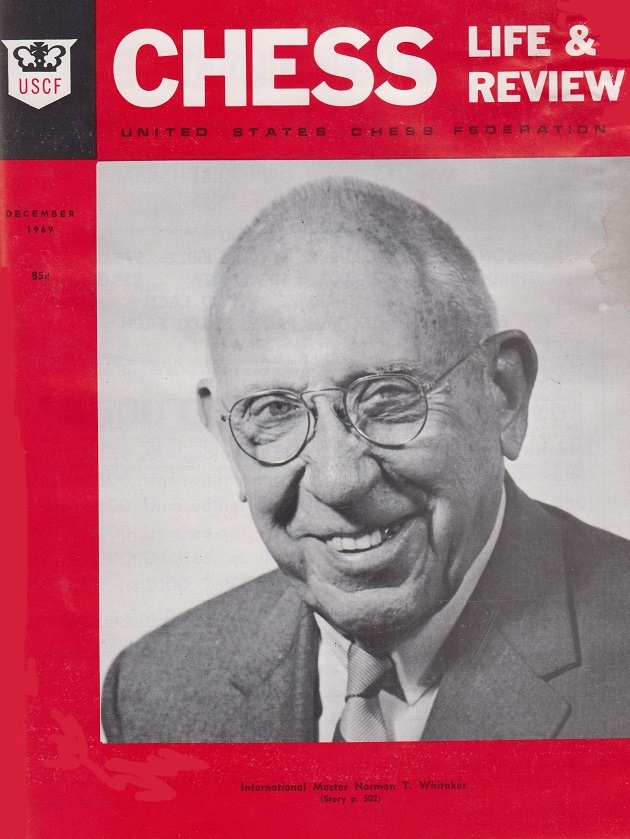
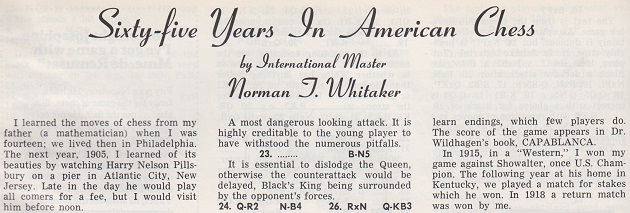
The chess accomplishments related included this curiosity (about which more information is sought):
‘In Hamburg, in May 1960, I drew a hard-fought six-game match with Grandmaster F. Sämisch, for stakes. We each won a game, with four draws. He is tough, as expected of a veteran master; he once defeated the dreaded Capablanca.’
Whitaker also showed ‘the only problem I ever composed’:
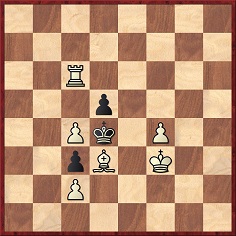
Mate in three.
Page 26 of the January 1970 issue gave the solution.
The extraordinarily convoluted preparation of Whitaker’s article for publication in Chess Life & Review is related on pages 281-285 of John Hilbert’s biography.
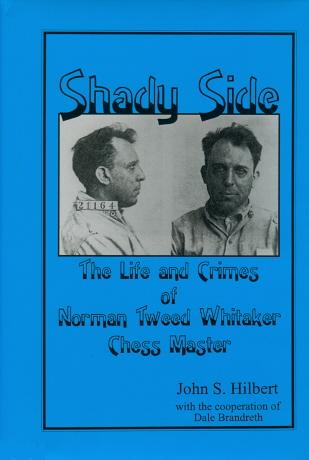
11214. Chess in Hastings
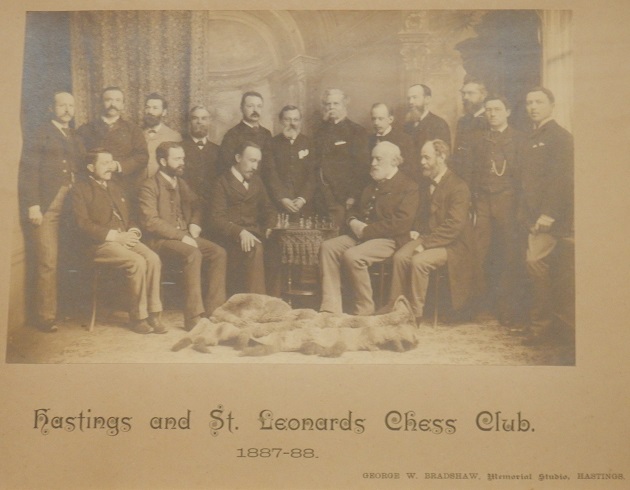
This photograph has been provided by Tim Jones (Liverpool, England), from the memorabilia of his grandfather Richard Jones, who is second from the left in the front row. It seems that the player seated by the black pieces is F.W. Womersley.
A further photograph (in which Richard Jones is again second from the left in the front row, the occasion being a Sussex v Surrey match in 1886) is on our correspondent’s website. He also possesses the London, 1883 tournament book with this inscription: ‘Won by Richard Jones in the Even Tournament of the Hastings and St Leonards Chess Club, Autumn 1884, together with the captaincy of the club for 1885.’

Chess Player’s Chronicle, 17 December 1884, page 259
Two of the game-scores in Richard Jones’ hand:
Richard Jones – Frederick William Womersley
Handicap tournament, Hastings, 6 March 1885
Giuoco Piano
1 e4 e5 2 Nf3 Nc6 3 Bc4 Bc5 4 Nc3 Nf6 5 O-O O-O 6 d3 d6 7 h3 Be6 8 Bb3 Bxb3 9 axb3 h6 10 Ne2 Nh7 11 Ng3 Ne7 12 Nh4 d5 13 exd5 Qxd5 14 Ne4 f5 15 Nxc5 Qxc5 16 Be3 Qc6 17 f4 e4 18 dxe4 fxe4 19 Bd4 Nf5 20 Nxf5 Rxf5 21 Qg4 Rf7 22 c3 a6 23 f5 Raf8 24 Rae1 Qd5 25 Qg6 c5 26 Be3 Rf6 27 Qg4 b6 28 Rd1 Qf7 29 Qxe4 Rxf5 30 Rxf5 Qxf5 31 Qb7 Qc2 32 Rd7 Qg6 33 Qxa6 Qb1+ 34 Kh2 Qxb2 35 Qc4+ Kh8 36 Rb7 Rf6 37 Bf4 Ng5 38 Bxg5 hxg5 39 Rb8+ Kh7 40 Qe4+ Rg6 41 Rxb6 Resigns.
Frederick William Womersley – Richard Jones
Club tournament, Hastings, 16 October 1885
Ruy López
1 e4 e5 2 Nf3 Nc6 3 Bb5 a6 4 Ba4 Nf6 5 d4 exd4 6 O-O Bc5 7 Bg5 h6 8 Bh4 g5 9 Bg3 Nh5 10 Bxc6 dxc6 11 Be5 f6 12 Bxd4 Bd6 13 e5 Be7 14 exf6 Nxf6 15 Qd3 Rg8 16 Re1 Nd5 17 Qh7 Kf8 18 Qxh6+ Ke8 19 Nxg5 Bf5 20 Bc5 b6 21 Bxe7 Nxe7 22 Nc3 Qd2 23 Qxc6+ Qd7 24 Qxa8+ Qd8 25 Qc6+ Resigns.

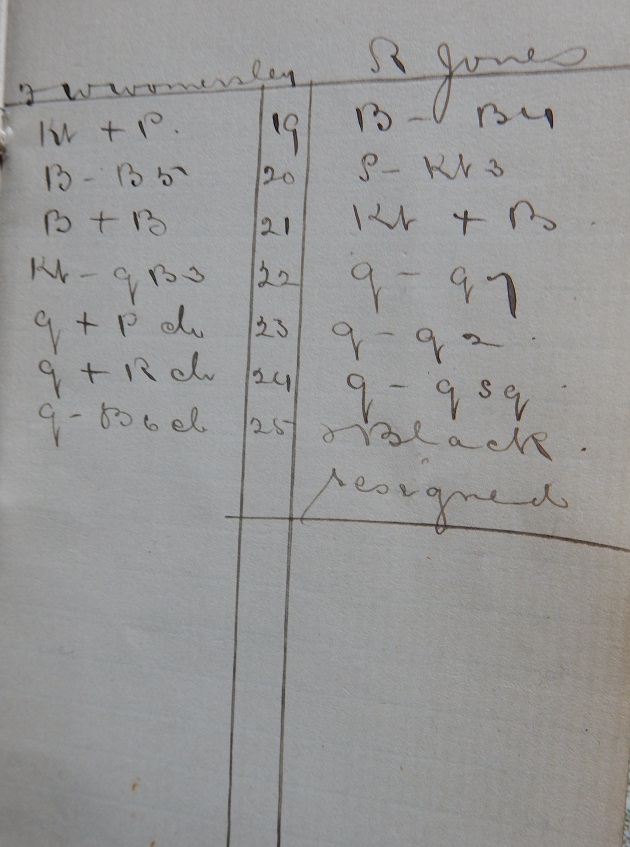
Dr Richard Jones was born in Gwter Fawr (later name: Brynaman/Brynamman), on 16 July 1859 and died in the same Welsh village on, as far as is known, 25 January 1940.
11215. ‘The greatest annotator who ever lived’
‘It is my considered opinion that Paul Keres is the greatest annotator who ever lived.’
Burt Hochberg, a much underrated writer, made that comment in a laudatory review of the final volume of the Keres trilogy Grandmaster of Chess on pages 236-237 of the June 1969 Chess Life. (The production standards of the US publisher, Arco, were, however, criticized.)
After possible competing claims in favour of Alekhine, Botvinnik and Fischer had been noted briefly (with mention too of Bronstein), Hochberg wrote:
‘Keres is profound, analytically sound, most readable and instructive. He omits nothing, save the most obvious and trivial. But perhaps the feature that sets him above all the others is his sense of form. A game of chess, in common with some other forms of art, has a beginning, a middle and an end, one phrase preparing the next, every move part of a planned organic whole. In his notes, Keres imparts to the game a sense of direction, a feeling of anticipation and the sure knowledge that nothing has been left to chance, that everything has been taken into account. At frequent intervals, Keres reminds us of each player’s earlier strategic goals, pointing out the strengths and weaknesses of each position and setting forth the plans of each player for the next stage of the game. He also shares with the reader his own thoughts during the game. One frequently encounters the phrase, “During the game, I intended ...”.’
Keres was a columnist in Chess Life and Chess Life & Review, and in 1991 Hochberg brought out an excellent anthology, Power Chess.
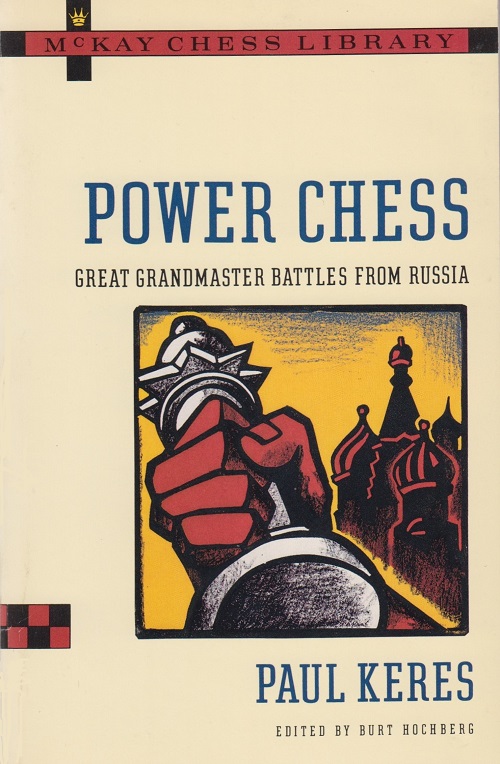
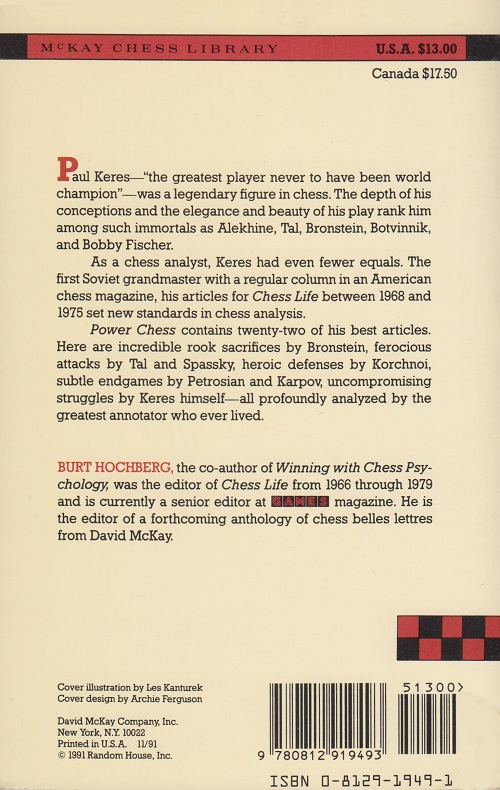
The chess belles lettres book by Hochberg referred to in the back-cover blurb was The 64-Square Looking Glass (New York, 1993).

11216. G.W. Medley
From Hans Renette (Bierbeek, Belgium):
‘Very recently, Nigel and Caroline Webb (who contributed some photographs from their family archive for my books on Bird, Neumann and Paulsen) published a biography of George Webb Medley and his wife, entitled Mr Sugar Face and his Moll (Legini Press). It contains a fairly extensive chapter on chess.’
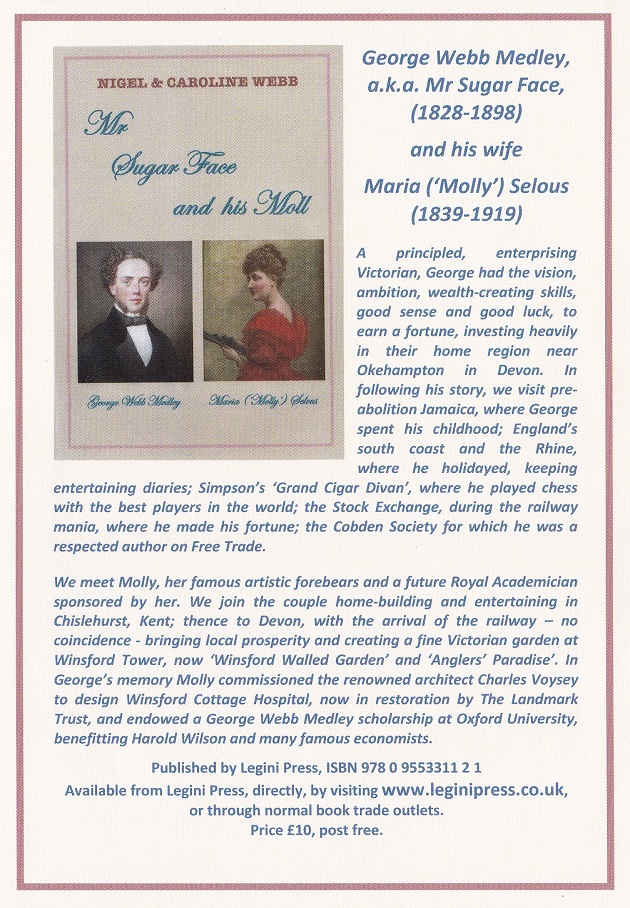
11217. Spielmann on Masters of the Chess Board
Wanted: further information about Rudolf Spielmann’s assessment of Masters of the Chess Board by Richard Réti.
The first of two pages of testimonials in Richard Réti: Sämtliche Studien (Mährisch-Ostrau, 1931), from the same publisher as Die Meister des Schachbretts (Mährisch-Ostrau, 1930):
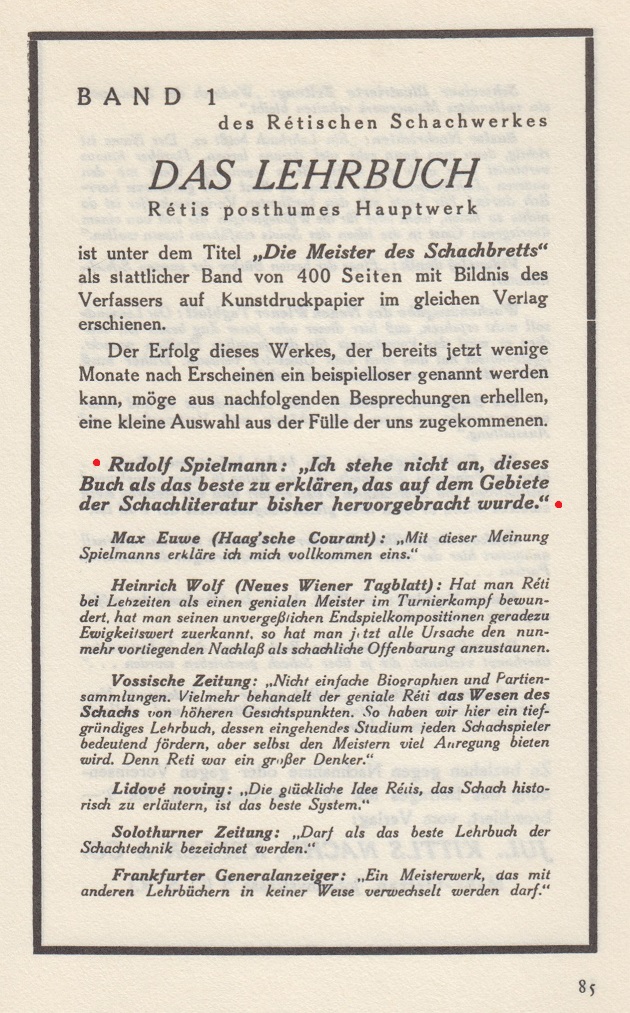
Below is the penultimate (unnumbered) page of Chess Strategy and Tactics by Fred Reinfeld and Irving Chernev (New York, 1933):
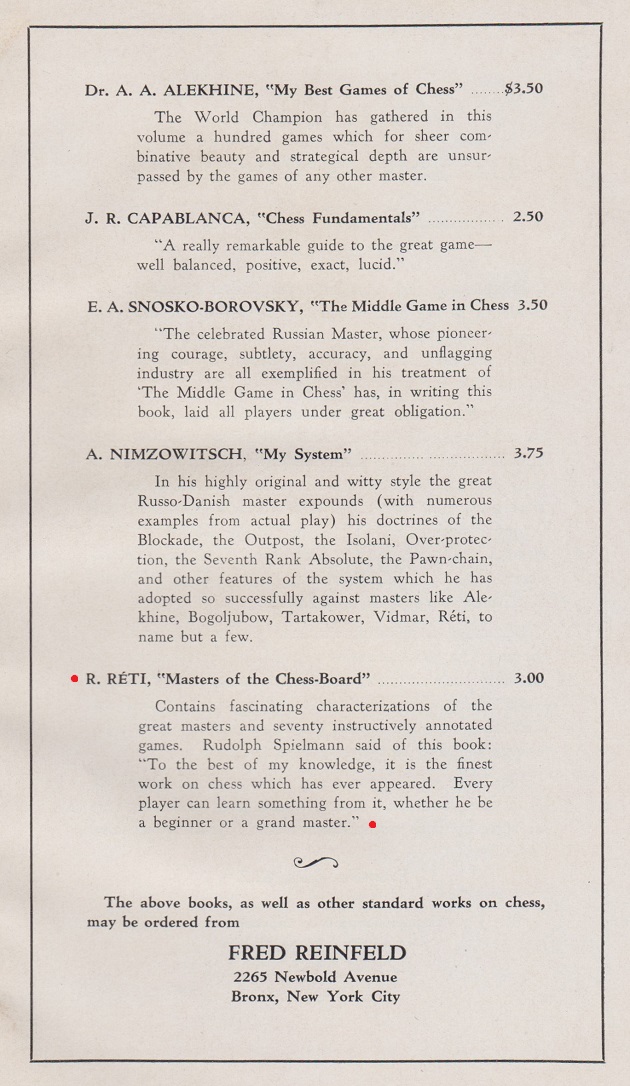
11218. L. Lindheimer
C.N.s 11201 and 11202 mentioned L. Lindheimer, further to his remark, ‘Littlewood plays the best bad chess I have ever seen’.
John Townsend (Wokingham, England) writes:
‘Leopold Franz Lindheimer was born on 20 November 1902 in Berne, Switzerland according to the National Archives on-line catalogue entry for document HO 396/55/256. The text has not been examined. It belongs to a class of records concerned with internment during the Second World War.
A naturalization certificate was issued on 27 April 1946, specifying that he was from Germany and resident at that time in Banstead, Surrey, his wife being named as Anita Gerda Helene. (Source: National Archives catalogue description of HO 334/162/18010.)
The indexing of his marriage in the June quarter of 1936 (Kensington, 1a, 385) by the General Register Office states that his spouse was Anita G.H. Brasch or Anita G.H. Seldis.
At the time of the “National Registration: 1939 Register” (National Archives, RG 101/361), he was living at 71 Dorchester Court, Lambeth, described as a hair and wool merchant, and carrying out Air Raid Precautions duties as a stretcher-bearer, while his wife was an ambulance driver. His date of birth was again given as 20 November 1902; his wife’s was 12 February 1910.
The National Probate Calendar shows that he died on 31 August 1962 at the Hospital Clínico, Barcelona, his residence at the time being Old Point, Woodlands Road, Virginia Water, Surrey. Probate was granted on 16 November to his widow, his effects amounting to £22,202 5s.’
The sole game by Lindheimer that we have seen in databases is his victory over W.W. Aves in the Bognor Regis Club Championship, 1961. Under the heading ‘Double-Sacrifice at KB6’, Raaphy Persitz annotated it in depth on pages 146-149 of the May 1962 BCM, and the score is given below with, as a guide, his punctuation:
1 e4 e5 2 Nf3 Nc6 3 Bc4 Bc5 4 c3 Nf6 5 O-O? d6? 6 d4 exd4 7 cxd4 Bb6 8 Nc3 Bg4 9 Be3 h6? 10 Be2? O-O 11 h3 Bh5 12 d5 Bxe3? 13 fxe3? Ne7! 14 Nh4 Bxe2(?) 15 Qxe2 Qd7?? 16 Rxf6! gxf6 17 Qh5 Kg7 18 Rf1 Rh8
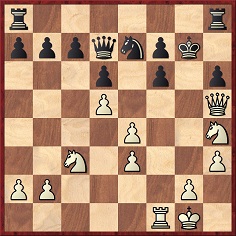
19 e5! dxe5 20 Rxf6! Kxf6 21 Ne4+ Kg7 22 Qxe5+ f6 23 Nxf6! Nc6 24 Nh5+ Kg8 25 Qg3+! Kf8 26 Ng6+ Kf7 27 Nxh8+(!) Rxh8(?) 28 Qg7+ Ke8 29 Nf6+ Resigns.
In his introduction, Persitz wrote that the game featured a ‘disrupting-sacrifice’ (move 16), a ‘clearing-sacrifice’ (move 19) and a ‘denuding-sacrifice’ (move 20). His note to 20 Rxf6 drew a comparison with the position at move 17 in the Capablanca v Steiner living chess game.
11219. Buenos Aires, 1927
Eduardo Bauzá Mercére (New York, NY, USA) has forwarded some photographs which he took on 30 January 2019 at the Club Argentino de Ajedrez, Paraguay 1858, Ciudad Autónoma de Buenos Aires, 1120, Argentina. In the shot below, the Club’s display of the board and pieces used for the 1927 world championship match is intended to show the final position in the decisive 34th match-game, after 82 Re7:
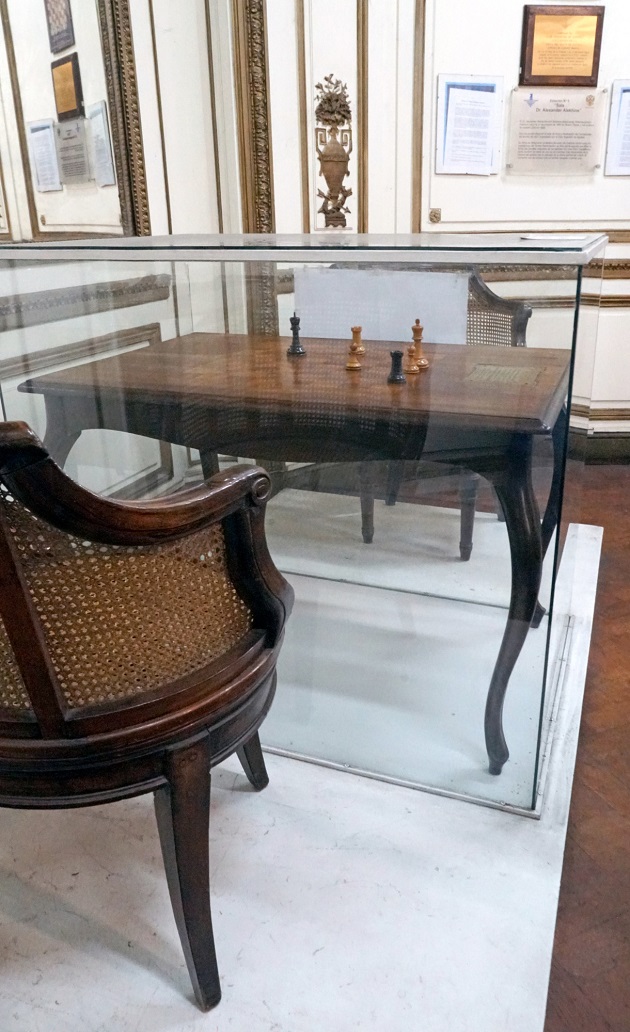
Mr Bauzá Mercére notes that the black rook is on h2, and not h1 as in the game.
We add page 4 of the Argentine newspaper Crítica, 29 November 1927:
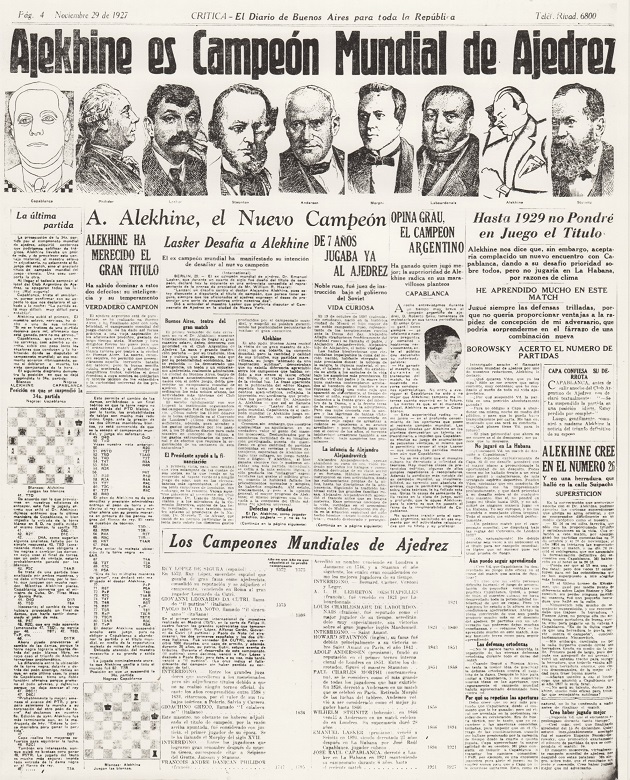
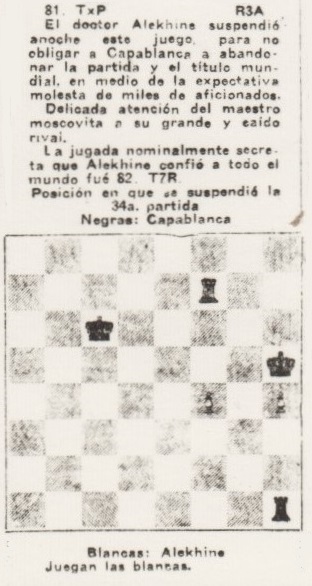
11220.
Pilnik v Ólafsson
A heading on page 157 of CHESS, 11 February 1956:

Persitz annotated the game (Pilnik v Ólafsson, Reykjavik, 1955) on pages 158-160. (1 e4 e5 2 Nf3 Nf6 3 Nxe5 d6 4 Nf3 Nxe4 5 d4 d5 6 Bd3 Be7 7 O-O O-O 8 Re1 Nd6 9 Nc3 c6 10 Bf4 Bg4 11 h3 Bh5 12 Bh2 f5 13 Ne2 g5 14 Ng3 Bg6 15 Ne5 Nd7 16 Nxg6 hxg6 17 Qe2 Rf7 18 Nf1 Ne4 19 f3 Nd6 20 c3 Nf8 21 Qc2 Ne8 22 Re2 Bd6 23 g3 Ng7 24 Rae1 Qf6 25 Kg2 Nge6 26 Bg1 Rd8 27 Rd1 Rh7 28 c4 g4 29 fxg4 Bxg3 30 Nxg3 Rxh3 31 gxf5 Nf4+ 32 Kf3 Qh4 33 Bf2 Nh7 34 Rg1 Ng5+ 35 Ke3 Re8+ 36 Kd2 Nf3+ 37 Kc3 Nxe2+ 38 Nxe2 Qxf2 39 Rxg6+ Kh8 40 Qc1 Re3 41 Nf4 Re1 42 White resigns.)
See too pages 29-33 of Við skákborðið í aldarfjórðung by Friðrik Ólafsson (Reykjavik, 1976). Page 29 has a photograph of the players at the board.
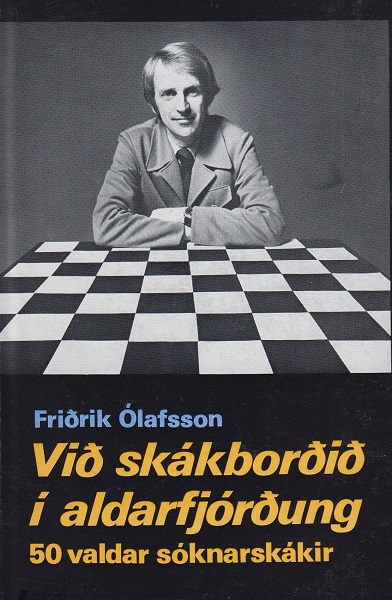
11221. Capablanca’s influence on Benko
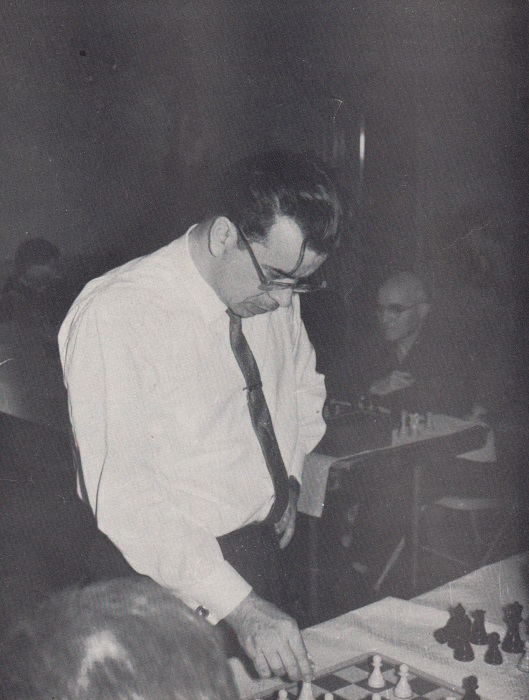
Pal Benko, front cover, Chess Review, October 1961
On page 157 of Winning with Chess Psychology by Pal Benko and Burt Hochberg (New York, 1991) Benko wrote:
‘About a year after Lasker’s death, Capablanca died, and a book appeared in Hungary containing 300 of his games, many of them annotated by grandmasters. Although Lasker remained my idol, Capablanca’s games taught me technique and enabled me, at age 17, to become a master.’
On page 4 of Pal Benko My Life, Games and Compositions by P. Benko and J. Silman (Los Angeles, 2003) Benko recalled:
‘I avidly studied a book of Capablanca’s 350 best games (this was my first chess book and the Cuban quickly became my chess hero).’
The book was by Ferenc Chalupetzky and László Tóth (Kecskemét, 1943). It had 319 numbered games and some fragments.
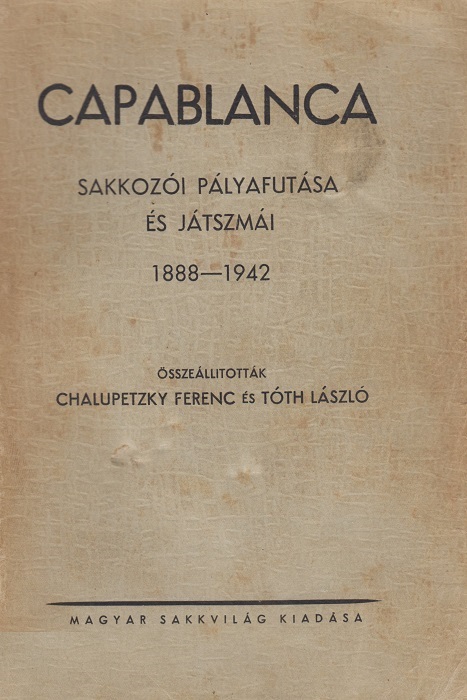
11222. Fischer v Benko, and simultaneous displays
From page 288 of My 60 Memorable Games by Bobby Fischer (New York, 1969), in game 46:
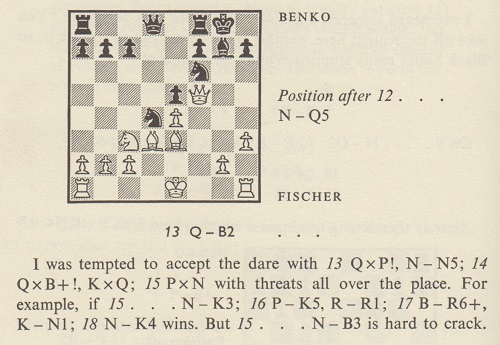
In a report on a simultaneous exhibition by Fischer in Toronto on 27 February 1964, Wayne D. Komer noted on page 223 of CHESS, April 1964 that Fischer first gave a 45-minute talk on that game against Benko (1963-64 US Championship):
‘He drew a large chuckle from the crowd when he said that after studying the board [in the diagrammed position] he decided not to play 13 QxKP and then sacrifice the queen for the bishop after 13...N-N5 (14 QxBch KxQ 15 PxN) because he thought this game would then detract from his (brilliant) victory over Robert Byrne in round three when it came time for the judges to award the brilliancy prize.’
The full article has been reproduced in A Legend On the Road by John Donaldson (Seattle, 1994 and Milford, 2005). See pages 20-21 and 34 respectively.
On page 307 of the mid-June 1964 CHESS Wayne D. Komer gave additional information on the Toronto exhibition, including the following:
‘The director of play requested that no-one should ask to “pass” during the simul. This is invariably stated before the games begin, at all the displays that I have attended, and the players generally adhere to the request. One player did ask to pass, but Bobby agreed immediately and went on to play the next board with total unconcern.’
The topic of ‘passing’ (mentioned also in C.N. 5127 with regard to Alekhine and Capablanca) had been raised on page 185 of CHESS, 29 February 1964, when the Editor, B.H. Wood, reported on an exhibition of his in West Kirby. That prompted some reminiscences (see C.N. 4958) about Kostić and Alekhine from H.H. Watts on page 232 of the April 1964 issue:
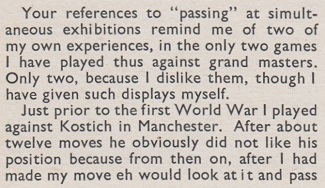
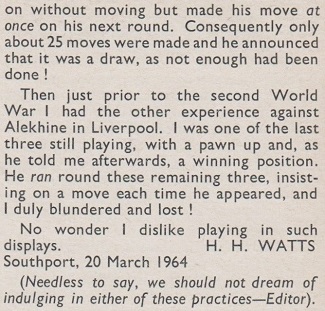
CHESS reverted to the subject the following decade, and C.N. 9531 quoted Wolfgang Heidenfeld on page 257 of CHESS, June 1973, in a letter headed ‘Rabbits and Nonsense’:
‘Your correspondence about simultaneous display etiquette is becoming boring, especially as most of the views represented are those of rabbits who do not even know the rules.’
One complaint, by Phillip G. Clinker, had been about Karpov, on page 229 of the May 1973 issue:
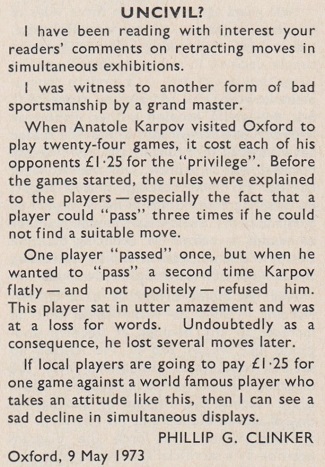
11223. Lugano, 1968
‘The Lugano Olympiad was the greatest manifestation of international chess the world has yet seen.’
That was the first sentence of Harry Golombek’s column in The Times, 16 November 1968, page 23.

On page 334 of the December 1968 BCM Golombek reported that the conditions were not perfect:
‘Whenever spectators became numerous the air supply was not really adequate and the noise that echoed round the hall, admittedly mostly made by the players themselves when they had finished their games, proved very difficult to control. In this respect I formulated one axiom and made one observation that may be of use to students of social behaviour. The axiom is the weaker the player the bigger the noise, and to those who say “What about Najdorf?” my reply is that Najdorf is not what he was either as player or creator of noise. The observation, which was borne in on me repeatedly, is that by far the greatest decibels of noise are produced by heavily moustached gentlemen from South America. Possibly the scientific reason for this is the greater force necessary to make themselves heard through the hair.’
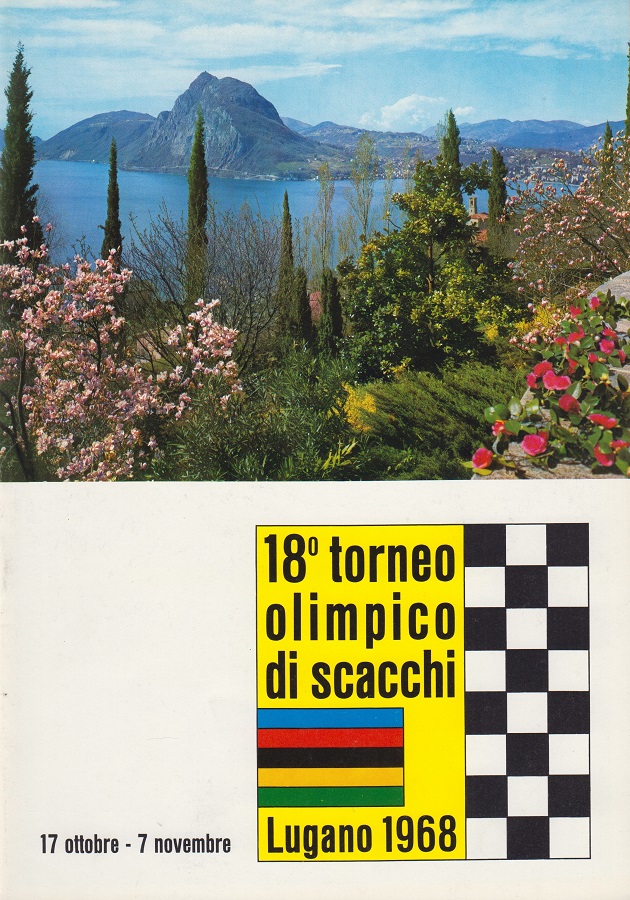
The 28-page programme had a message from the FIDE President, Folke Rogard:

11224. Oskam v Reyss (C.N. 11206)
Alan Smith (Stockport, England) mentions that he gave Oskam v Reyss, Rotterdam, 1931 on pages 620-621 of the October 2016 BCM, his source being page 2 of Het Vaderland, 28 December 1931.
11225. Réti on Morphy
From page 11 of Masters of the Chess Board by Richard Réti (London, 1933):
‘His contemporaries reproached Morphy with a certain dryness, a criticism which has been levelled against every world’s champion before and after him.’
The original text, on page 29 of Die Meister des Schachbretts (Mährisch-Ostrau, 1930):
‘Von seinen Zeitgenossen wurde Morphy, gleich allen anderen Weltmeistern vor und nach ihm, Trockenheit vorgeworfen.’
Wanted: examples of Morphy being accused of dryness by his contemporaries.
11226. The Termination
15 February 1985 was ‘a day of shame in the history of chess’, according to page 2 of Child of Change by Garry Kasparov with Donald Trelford (London, 1987), and today, exactly 34 years after the Termination of the first Karpov v Kasparov world championship match, we have received The Longest Game by Jan Timman (Alkmaar, 2019).
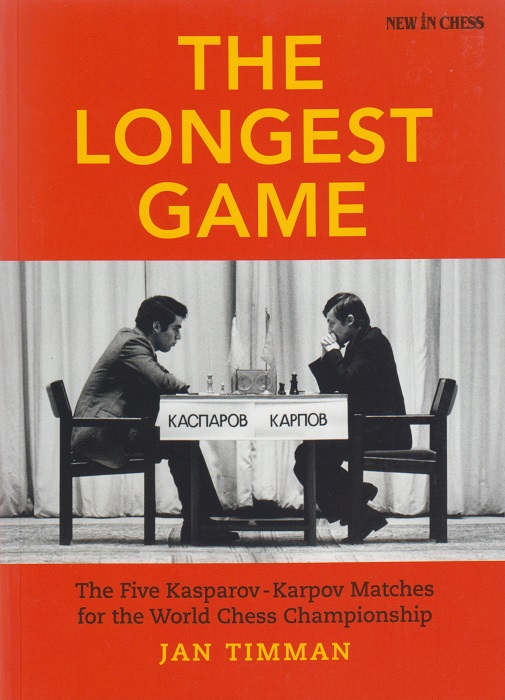
It is welcome that Timman’s account of the Termination on pages 70-77 highlights the unreliability of various claims presented to the public in 1985-87.
As regards the 1986 world title match, on page 144 there is no mincing of words by Timman about A Unique Chess Writer:
‘Karpov did not have a clear delegation leader, but he did have a press attaché: the Yugoslav Dmitri Bjelica. That was a strange choice, as Bjelica was known as a gutter journalist who wrote books that were full of printing errors and plagiarisms.’
11227. Translations
Some remarks by H.J.R. Murray on the subject of Pre-Chess Chess Quotes:
‘If we were to accept the statements of translators we should believe that Adam and Eve, Solomon, the ancient Egyptians, Greeks and Romans, the inhabitants of America before the time of Columbus, all played chess. When a translator finds a game mentioned in the text he is translating, he naturally replaces its name by the name of a game which is familiar to his readers and which enjoys a like reputation. The serious historian has to go behind the translation to the original texts.’
Source: a letter from H.J.R. Murray headed ‘Chess in Ireland’ on pages 503-504 of the December 1933 BCM.
11228. Réti on Capablanca
From page 153 of Masters of the Chess Board by Richard Réti (London, 1933), in the chapter on Capablanca:
‘In a sense, chess is his mother tongue.’
On the Internet we have seen no occurrences of the exact original German text, as published on page 279 of Die Meister des Schachbretts (Mährisch-Ostrau, 1930):
‘Das Schach ist ihm gewissermaßen Muttersprache.’
C.N. 5557 made an analogous comment about Nimzowitsch’s dictum ‘First restrain, next blockade, lastly destroy’ (‘Zuerst hemmen, dann blockieren und schließlich vernichten’).
11229. Paranoia
Pages 25-26 of the Magazine Section of the Sunday Times, 26 November 1961 had an article entitled ‘The Mind of the Russians’ by Lord Taylor, introduced as follows:
‘For generations the Russians have been the great enigma: the Revolution has shrouded their personality still more. Lord Taylor, psychiatrist and politician, here uses the techniques of modern scientific analysis to disentangle their complex make-up.’
Page 26 had this text:
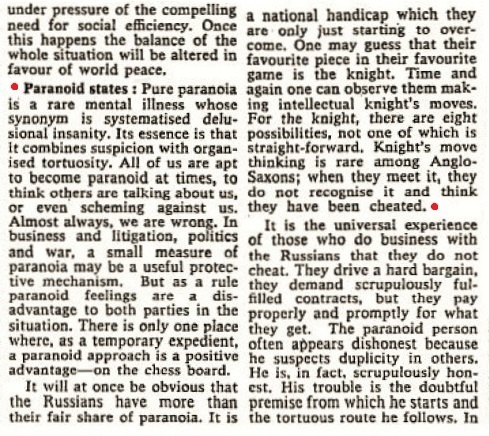
Nowadays, one could expect immediate reports that ‘furious’ readers ‘took to Twitter’ to ‘shut down’ Lord Taylor, but CHESS held back for nearly nine months:
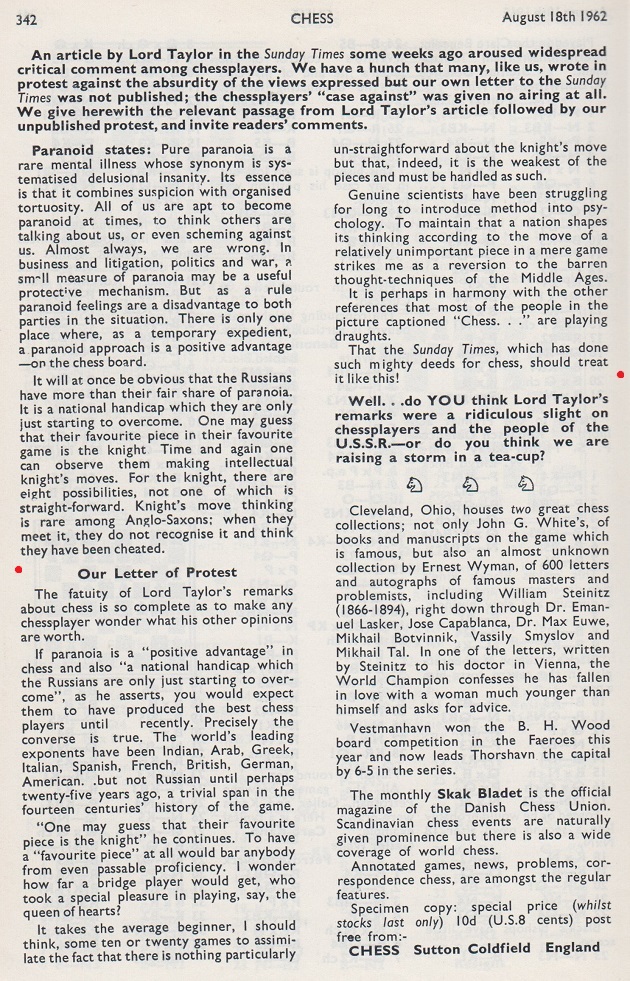
After another long wait, CHESS readers were allowed to chime in, on pages 137-138 of the February 1963 issue. One sentence from the heading:
‘Many letters received, if printed, would have landed us in the law courts.’
The tardy publication of the original feature in CHESS and the heading’s reference to ‘the Sunday Times some weeks ago’ have resulted in Lord Taylor’s article being dated 1962, rather than 1961, by a number of writers. See, for instance, page 43 of Soviet Chess by D.J. Richards (Oxford, 1965).
11230. Chess in Hastings (C.N. 11214)
Tim Jones (Liverpool, England) sends a further game from the archives of his grandfather, Richard Jones:
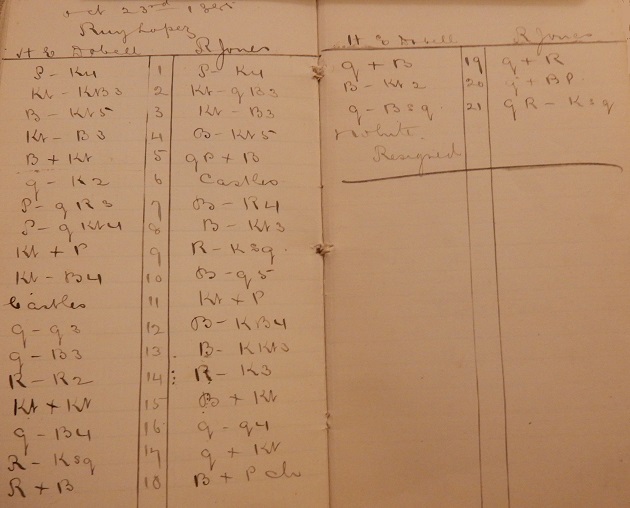
Dobell v Jones, Hastings, 23 October 1885: 1 e4 e5 2 Nf3 Nc6 3 Bb5 Nf6 4 Nc3 Bb4 5 Bxc6 dxc6 6 Qe2 O-O 7 a3 Ba5 8 b4 Bb6 9 Nxe5 Re8 10 Nc4 Bd4 11 O-O Nxe4 12 Qd3 Bf5 13 Qf3 Bg6 14 Ra2 Re6 15 Nxe4 Bxe4 16 Qf4 Qd5 17 Re1 Qxc4 18 Rxe4 Bxf2+ 19 Qxf2 Qxe4 20 Bb2 Qxc2 21 Qf1 Rae8 22 White resigns.
We turn now to Herbert Edward Dobell (1864-1938).

Chess Personalia by Jeremy Gaige (unpublished 1994 edition)
The obituary of Dobell on page 16 of the Hastings and St Leonards Observer, 17 September 1938:


The newspaper’s photograph was reproduced on page 48 of CHESS, 14 October 1938:
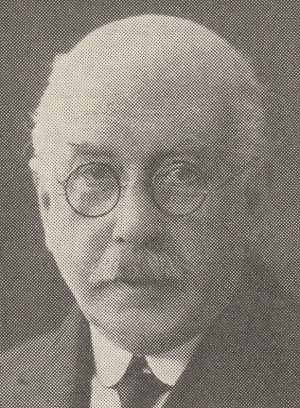
A 1935 article by Dobell about Hastings chess was published on pages 270-272 of the December 1943 BCM. He played a key role in the organization of Hastings, 1895 and appears in the rarer of the two group photographs of the tournament (see, for instance, C.N. 10254). His standing is further demonstrated by the report on pages 111-112 of the March 1908 BCM of a presentation to him in Hastings on 19 February 1908, an event attended by Blackburne. An extract from page 112:
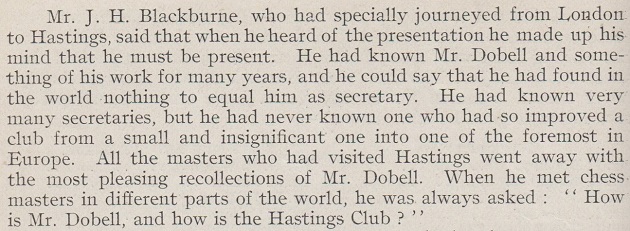
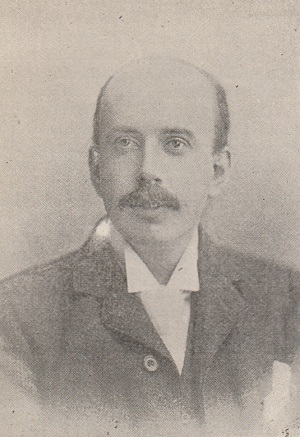
Herbert Edward Dobell, BCM, October 1895, page 409
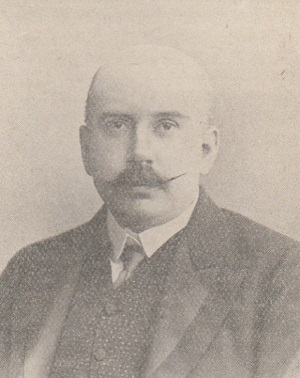
Herbert Edward Dobell, BCM, October 1904, page 395
Below is a detail of the group photograph of ‘the Hastings Club Touring Team, 1901’ which was the frontispiece to the October 1901 BCM:
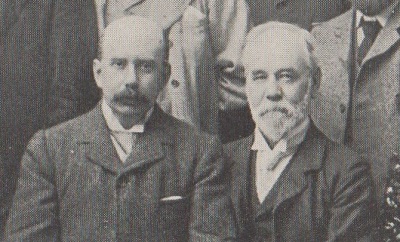
Herbert Edward Dobell and Frederick William Womersley
Chess magazines had relatively few games by Dobell. This victory over S. van Gelder, played during the above-mentioned tour, was on page 410 of the October 1901 BCM:
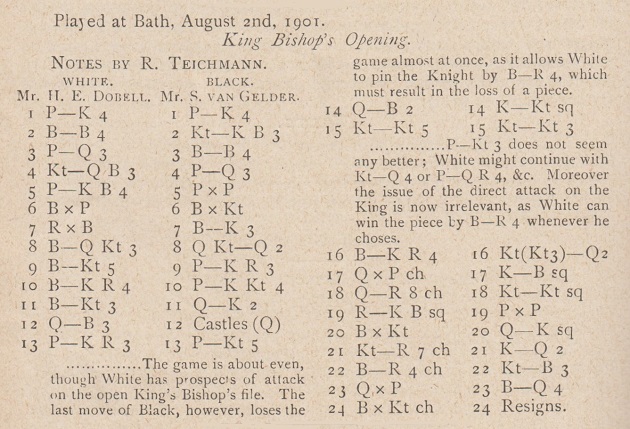
1 e4 e5 2 Bc4 Nf6 3 d3 Bc5 4 Nc3 d6 5 f4 exf4 6 Bxf4 Bxg1 7 Rxg1 Be6 8 Bb3 Nbd7 9 Bg5 h6 10 Bh4 g5 11 Bg3 Qe7 12 Qf3 O-O-O 13 h3 g4 14 Qf2 Kb8 15 Nb5 Nb6 16 Bh4 Nbd7 17 Qxa7+ Kc8 18 Qa8+ Nb8 19 Rf1 gxh3 20 Bxf6 Qe8 21 Na7+ Kd7 22 Ba4+ Nc6 23 Qxb7 Bd5 24 Bxc6+ Resigns.
A good source for Dobell’s games is the chess column in the Hastings and St Leonards Observer, and a selection follows.
Frederick William Womersley and Walker – Herbert
Edward Dobell and H.R. Mackeson
Consultation tournament, Hastings, 1898
Queen’s Gambit Declined
1 c4 e6 2 Nc3 Nf6 3 Nf3 d5 4 e3 Be7 5 d4 Nbd7 6 b3 c5 7 Bb2 O-O 8 Be2 b6 9 Rc1 Bb7 10 O-O Re8 11 dxc5 Bxc5 12 cxd5 Nxd5 13 Bb5 Re7 14 Ne4
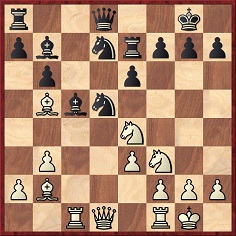
14...Nxe3 15 Nxc5 Nxd1 16 Nxb7 Qb8 17 Rfxd1 Qxb7 18 Bc6 Qb8 19 Bxa8 Qxa8 20 Rc7 Qe8 21 Nd4 Nb8 22 Rc2 Rd7 23 Rdc1 h6 24 Nb5 Qd8 25 Bd4 Qg5 26 a4 a6 27 Be3 Qh5 28 Rc8+ Kh7 29 Nc3 Rb7 30 Ne4 Qd5 31 R8c4 e5 32 Ng3 g6 33 h3 Nd7 34 Kh2 f5 35 Nf1 f4 36 Bd2 Nc5 37 b4 Nd3 38 Rc7+ Rxc7 39 Rxc7+ Kg8 40 Kg1 Qd4 and wins.
Source: Hastings and St Leonards Observer, 3 December 1898, page 3.
From a six-board blindfold exhibition:
Joseph Henry Blackburne – Herbert Edward Dobell
Hastings, 2 April 1900
Evans Gambit Accepted
1 e4 e5 2 Nf3 Nc6 3 Bc4 Bc5 4 b4 Bxb4 5 c3 Ba5 6 O-O d6 7 d4 Bb6 8 a4 Bg4 9 a5 Nxa5
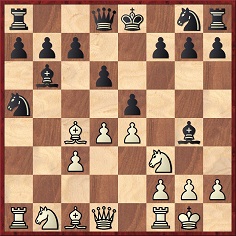
10 Rxa5 Bxa5 11 dxe5 dxe5 12 Bxf7+ Kf8 13 Qb3 Bxf3 14 Bxg8 Qf6 15 Ba3+ Ke8 16 gxf3 Bb6 17 Rd1 c5 18 Qe6+ Qxe6 19 Bxe6 Ke7 20 Bd5 Rhd8 21 Nd2 Rd7 22 Nc4 Kf6 23 Rb1 Re7 24 Nxb6 axb6 25 Rxb6+ Kg5 26 Bxc5 Resigns.
Source: Hastings and St Leonards Observer, 7 April 1900, page 2.
R.G. Drake – Herbert Edward Dobell
Hastings, 30 May 1900
Ruy López
1 e4 e5 2 Nf3 Nc6 3 Bb5 a6 4 Ba4 b5 5 Bb3 Bb4 6 O-O Qf6 7 c3 Ba5 8 d4 h6 9 Be3 Nge7 10 d5 Nd8 11 Nbd2 d6 12 Ne1 g5 13 Nd3 Ng6 14 g3 Bh3 15 Re1 h5 16 Nf3

16...Nf4 17 Bc2 Bg4 18 gxf4 gxf4 19 Bd2 Qg6 20 Kh1 h4 21 Qe2 Qh5 22 Bd1 Rg8 23 Rg1 h3 24 Nde1 Nb7 25 b4 Bb6 26 a4 O-O-O 27 axb5 a5 28 bxa5 Bxa5 29 c4 Rg7 30 Bxa5 Rdg8 31 Qc2 Qg6 32 Be2 Nc5 33 Bd3 Qh5 34 Be2 f5 35 Bb4 Nxe4 36 Bd1 Bxf3+ 37 Nxf3 Rxg1+ 38 Nxg1 Rxg1+ 39 Kxg1 Qg5+ ‘and mates in four moves’.
Source: Hastings and St Leonards Observer, 2 June 1900, page 6.
Frederick William Womersley and ally – Herbert
Edward Dobell and ally
Consultation tournament, Hastings, 1900
Vienna Gambit
1 e4 e5 2 Nc3 Nf6 3 f4 d5 4 fxe5 Nxe4 5 Nf3 Be7 6 g3 O-O 7 Qe2 Ng5 8 d4 Bg4 9 Bg2 c6 10 Be3 Ne4 11 Nd1 f6 12 Qd3 Nd7 13 Nf2 Bxf3 14 Bxf3 Nxf2 15 Bxf2 fxe5 16 Qb3 Qa5+ 17 Kf1 Rf7 18 Be1 Qc7 19 Kg2 exd4 20 Bg4 Nc5 21 Qb4 Qe5 22 h3 Raf8 23 Rd1 Qe4+ ‘and mate in three follows’.
Source: Hastings and St Leonards Observer, 22 December 1900, page 7.
Herbert Edward Dobell – F.A. Toyne
Club championship, Hastings, 1901
Bishop’s Opening
1 e4 e5 2 Bc4 Nf6 3 d3 Bc5 4 Nc3 d6 5 f4 exf4 6 Bxf4 Nc6 7 Nf3 Bg4 8 Rf1 Na5 9 Bb3 Nxb3 10 axb3 O-O 11 h3 Be6 12 Bg5 h6 13 Bh4 Qe7 14 Qd2 Bb4 15 Nh2 Kh7 16 O-O-O Rg8 17 d4 g5
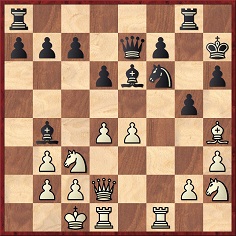
18 Qd3 Rg6 19 Be1 Bxc3 20 Bxc3 Bd7 21 Rde1 a6 22 Rf2 Nh5 23 d5 f6 24 Nf3 Re8 25 Qd4 Qd8 26 Qd3 Re7 27 Qd1 Ng3 28 Nd2 f5 29 Qf3 f4 30 h4 Qe8 31 hxg5 hxg5 32 Nf1 Rxe4 33 Rxe4 Qxe4 34 Nxg3 Qxf3 35 Rxf3 fxg3 36 Rf7+ Kh6 37 Rxd7 and wins.
Source: Hastings and St Leonards Observer, 27 April 1901, page 7.
C.A. Plaister (Wiltshire) – Herbert Edward Dobell
(Hastings)
Correspondence team match, 1901-02
Albin Counter-Gambit
1 d4 d5 2 c4 e5 3 cxd5 Qxd5 4 Nc3 Qxd4 5 Qc2 Bb4 6 Bd2 Ne7 7 e3 Qc5 8 Rc1 c6 9 a3 Bxc3 10 Bxc3 Be6 11 Nf3 Nd7 12 b4 Qd6 13 Rd1 Qc7 14 Ng5 Bf5 15 e4 Bg6 16 f4 h6 17 Nf3 f6 18 fxe5 fxe5 19 Bc4
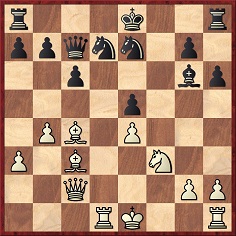
19...Nd5 20 Bxd5 cxd5 21 Rxd5 Rc8 22 Nxe5 Nxe5 23 Rc5 Nc6 24 b5 O-O 25 bxc6 Qf4 26 White resigns.
Source: Hastings and St Leonards Observer, 26 April 1902, page 6.
Herbert Edward Dobell (Hastings) – W. Boulger (Ibis
Chess Club, London)
Team match, Hastings, 1903
Petroff Defence
1 e4 e5 2 Nf3 Nf6 3 Nxe5 d6 4 Nf3 Nxe4 5 d4 Be7 6 Bd3 f5 7 Nbd2 d5 8 Ne5 O-O 9 O-O Nd7 10 f3 Ng5 11 Qe2 f4 12 c4 Nxe5 13 dxe5 dxc4 14 Bxc4+ Be6 15 Nb3 Kh8 16 Bxe6 Nxe6 17 Rd1 Qe8 18 Qc4 Rd8 19 Bd2 Bh4 20 Bb4 Rf7 21 g3 Bg5 22 h4
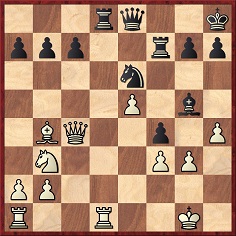
22...b5 23 Qe4 Be7 24 Bxe7 Qxe7 25 Rxd8+ Qxd8 26 Qc6 Nd4 27 Nxd4 Qxd4+ 28 Kg2 Rf8 29 Qxb5 fxg3 30 Qe2 Re8 31 Rd1 Qxh4 32 Rh1 Qd4 33 e6 Qd6 34 Rd1 Qe7 35 Re1 h6 36 Qe5 Qh4 37 Rh1 Qf6 38 Qxf6 gxf6 39 Rxh6+ Kg7 Drawn.
Source: Hastings and St Leonards Observer, 28 February 1903, page 7.
C.G. Skyrmer – Herbert Edward Dobell
Chapman Cup tournament, Hastings, 1904
Philidor’s Defence
1 e4 e5 2 Nf3 d6 3 Nc3 f5 4 d4 fxe4 5 Nxe4 d5 6 Nc3 e4 7 Ne5 Nf6 8 Bg5 Be6 9 Bb5+ c6 10 Ba4 Bb4 11 O-O Bxc3 12 bxc3
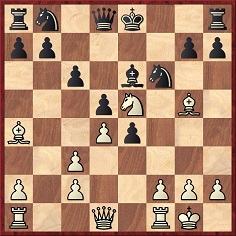
12...Qa5 13 Bxf6 gxf6 14 Qh5+ Ke7 15 Rab1 b5 16 Ng6+ hxg6 17 Qxh8 Qxa4 18 g4 Qxc2 19 g5 fxg5 20 Qg7+ Bf7 21 Qe5+ Kd7 22 Qxg5 Na6 23 Qf6 Rf8 24 Rxb5 cxb5 25 Qxa6 Qxc3 26 Qxa7+ Qc7 27 Qa3 Rh8 28 h3 Be6 29 Rc1 Qb8 30 Rc5 Rxh3 31 Rxd5+ Ke8 32 Qd6 Qxd6 33 Rxd6 Bxa2 34 Rxg6 Rd3 35 Rg5 Bc4 36 Re5+ Kd7 37 Rxe4 Kd6 38 Re8 Rxd4 39 f3 Kc5 40 Kf2 Kb4 41 Rf8 Kc3 42 f4 b4 and wins.
Source: Hastings and St Leonards Observer, 5 November 1904, page 2.
Herbert Edward Dobell (Hastings) – E.J. Brooks
(West London Club)
Team match, 1906
Petroff Defence
1 e4 e5 2 Nf3 Nf6 3 Nxe5 d6 4 Nf3 Nxe4 5 d4 Be7 6 Bd3 f5 7 O-O O-O 8 d5 Nd7 9 c4 Bf6 10 Nbd2 Ndc5 11 Bc2 Bd7 12 Rb1 Qe8 13 b4 Nc3 14 Qe1 Qxe1 15 Rxe1 Nxb1 16 Nxb1 Na6 17 a3 Rae8 18 Be3 b6 19 Rd1 Re7 20 Bd3 Nb8 21 c5 Rfe8 22 c6 Bc8 23 b5 h6 24 h4 Be5 25 g3 Bxg3 26 Bxb6 cxb6 27 fxg3 Re3 28 Kf2 f4 29 gxf4 Bg4
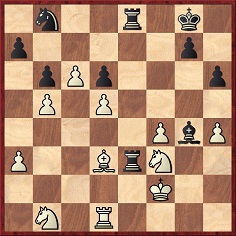
30 Ne5 R3xe5 31 fxe5 Bxd1 32 e6 Kf8 33 Nc3 Bb3 34 Ke3 Ke7 35 Bg6 Rd8 36 Kd4 Nxc6+ 37 bxc6 a6 38 Bd3 b5 39 Ne4 Rf8 40 Ng3 Rf4+ 41 Be4 and wins.
Source: Hastings and St Leonards Observer, 14 April 1906, page 5
Herbert Edward Dobell – A.G. Ginner
Chapman Cup, Hastings, 2 February 1907
Sicilian Defence
1 e4 c5 2 Nc3 e6 3 g3 Nc6 4 Bg2 g6 5 Nge2 Bg7 6 O-O Nge7 7 d3 O-O 8 Be3 d6 9 Qd2 f5 10 f4 e5 11 fxe5 Bxe5 12 d4 cxd4 13 Nxd4 Nxd4 14 Bxd4 Bxd4+ 15 Qxd4 Nc6 16 Qe3 Be6 17 a3 a6 18 Rad1 Qc7 19 Rf2 Rad8 20 Rfd2 Rfe8 21 Kh1 Kg7 22 Qd3 Qf7 23 b3 Re7 24 Qe2 Red7 25 Na4 Qf8 26 Nb6 Rf7 27 exf5 Bxf5 28 Na4 Rfd7 29 Qf2 Qe7 30 Nb6 Ne5 31 Nxd7 Rxd7 32 c4 Ng4 33 Qd4+ Kh6 34 h3 Nf6 35 g4 Be4 36 Bxe4 Nxe4 37 Qe3+ Kg7 38 Re1 Qg5 39 Rde2 Qxe3 40 Rxe3 Ng5 41 Re7+ Rxe7 42 Rxe7+ Kf6 43 Rxb7 Nxh3 44 Kh2 Ng5 45 Rb6 Ke5 46 Rxa6 and wins.
Source: Hastings and St Leonards Observer, 9 February 1907, page 2.
H.J. Stephenson – Herbert Edward Dobell
Bradley Martin Cup, Hastings, 9 October 1909
Sicilian Defence
1 e4 c5 2 Nf3 e6 3 d4 cxd4 4 Nxd4 Nc6 5 Nc3 g6 6 f4 Bc5 7 Nb3 Bb6 8 Nb5 a6 9 Nd6+ Kf8 10 c4 Ba7 11 h4 h5 12 c5 Bxc5 13 Nxc8 Bb4+ 14 Bd2 Bxd2+ 15 Qxd2 Rxc8 16 Nc5 Rc7 17 Qd6+ Kg7 18 Rd1 Nf6 19 Bc4
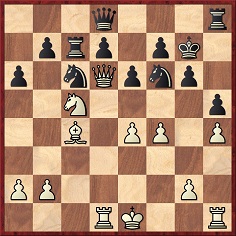
19...Ne8 20 Qd2 Qe7 21 Nd3 Nf6 22 e5 Ng4 23 Bb3 Rhc8 24 g3 Nd4 25 O-O Nxb3 26 axb3 Rc2 27 Qe1 Qd8 28 Nf2 Qb6 29 Rxd7 Ne3 30 Rd6 Qa7 31 f5 gxf5 32 Nd3 Ng2+ 33 White resigns.
Source: Hastings and St Leonards Observer, 16 October 1909, page 4.
Horace Fabian Cheshire – Herbert Edward Dobell
Bradley Martin Cup, Hastings, 1921
Caro-Kann Defence
1 e4 c6 2 d4 d5 3 Nc3 dxe4 4 Nxe4 Nf6 5 Nxf6+ gxf6 6 Nf3 Bf5 7 Bd3 Bg6 8 Bf4 Nd7 9 Qd2 e6 10 h4 Bh5 11 Be2 Nb6 12 O-O-O Nd5 13 Bg3 Qb6 14 c3 O-O-O 15 Nh2 Bxe2 16 Qxe2 Bh6+ 17 Kc2 Qa5 18 a3 Qa4+ 19 Kb1
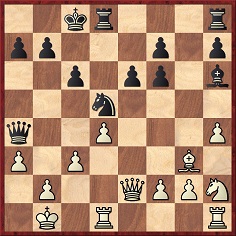
19...Qxa3 20 c4 Qa6 21 Qh5 Nb4 22 Qxh6 Qa2+ 23 Kc1 Qa1+ 24 Kd2 Rxd4+ 25 Ke2 Qxb2+ 26 Rd2 Re4+ 27 Kf3 Qc3+ 28 Kxe4 f5+ 29 White resigns.
Source: Hastings and St Leonards Observer, 26 November 1921, page 4.
11231. Hastings photographs
This photograph owned by Tim Jones (Liverpool, England) was mentioned in C.N. 11214:
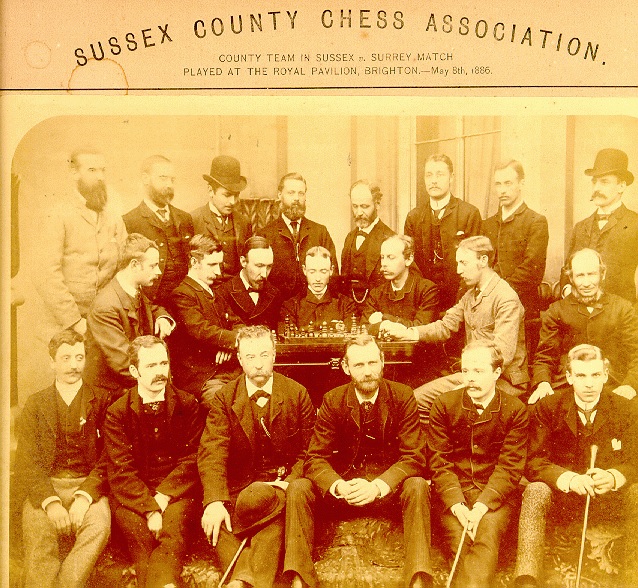
Our correspondent reported that his grandfather, Richard Jones, is seated second from the left in the front row.
Gerard Killoran (Ilkley, England) sends the result of the match as published on page 2 of the Morning Post, 17 May 1886:
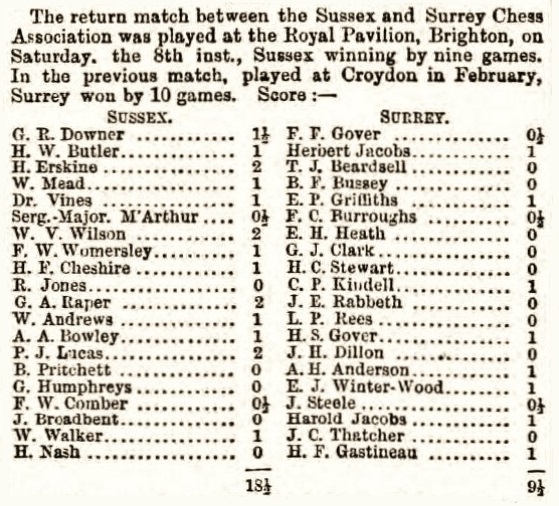
Readers’ assistance in identifying the players will be appreciated. The same applies to the other photograph discussed in C.N. 11214:

11232. The Quarterly for Chess History
Pages 563-571 of the latest edition (‘Spring 20/2019’) of the Quarterly for Chess History are devoted to a review-cum-demolition by the Editor, Vlastimil Fiala, of Vera Menchik by Robert B. Tanner (Jefferson, 2016). The final paragraph states that the book ‘should never have gone to print’.
As mentioned in C.N. 10191, the Menchik book is indeed very weak, but with his own track-record Vlastimil Fiala is an unsuitable person to complain, as he does on page 570, that it has ‘a large number of typos’. The review itself includes ‘J. Kaledovský’, ‘St Leonard’s’ (four times), ‘Bell’s of London Life’, ‘Sir G.H. Thomas’, ‘E. Eales’, ‘L’Echiquer’ (twice), ‘Hastings 19028/9’ and ‘Carslbad’.
Elsewhere, this new issue of the Quarterly contains, on pages 226-263, an article about Vienna, 1882 which refers to Berthold ‘English’, instead of Englisch, nine times. Pages 300-311 present some games played by Staunton in Scotland with the misspelling ‘Edinburg’ 12 times. On page 387 a game lost by Alekhine is dated ‘11.12.2930’. A sentence on page 420 refers to ‘Casablanca’ and ‘Miss M.T. Morra’.
11233. Ortueta v Sanz, Madrid, 1933
Two comments quoted in Ortueta v Sanz:
On 31...Rxb2:
‘After 45 minutes’ thought, Sanz had produced a thunderbolt with a rook sacrifice heralding one of the most remarkable endgames in the history of chess.’
Bruce Hayden, Chess Review, May 1964, page 136. (On the next page he also mentioned the consumption of 45 minutes for that move.)
On 34...a5:
‘This move took Sanz 45 minutes to work out and, according to him, was the most difficult of the whole “finale”.’
George Koltanowski, Chessnicdotes II (Coraopolis, 1981), page 97.
Alan McGowan (Waterloo, Canada) points out that there was also a reference to 45 minutes on page 175 of the May 1964 Deutsche Schachzeitung:
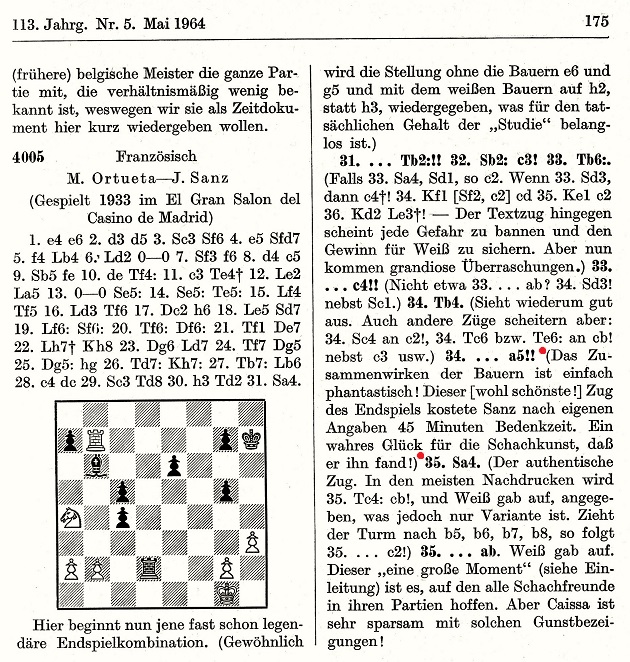
In the mid-1930s the game became one of the most famous ever played in Spain, and in 1964 it suddenly enjoyed a renacimiento de interés. We note that Koltanowski’s above-mentioned coverage of the game in Chessnicdotes II is similar to what had appeared in his syndicated column on, for instance, page 47 of the Indianapolis News, 2 January 1964:
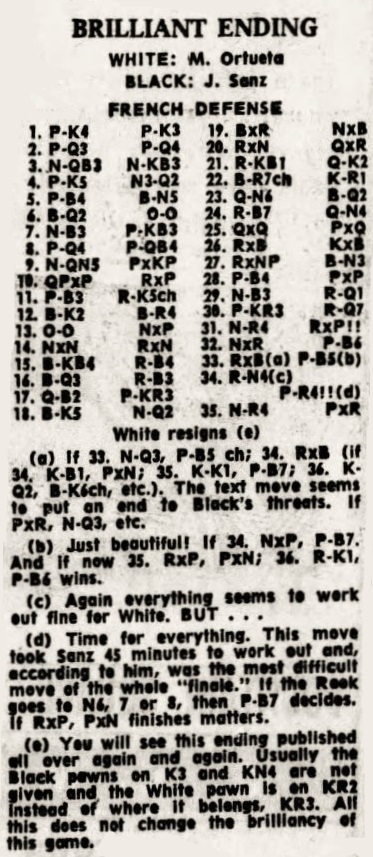
Alan McGowan draws attention to an item on page 14 of the Falkirk Herald, 26 June 1935:
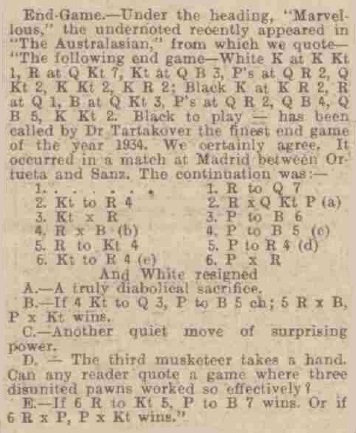
Although that cutting states that Tartakower considered the endgame the finest of 1934, our feature article shows that he correctly dated it 1933 on page 586 of L’Echiquier, 8 August 1934.
As another example of how the brilliancy was disseminated in the 1930s, below is a text, attributed to Action française, on pages 31-32 of the February 1936 Schweizerische Schachzeitung:
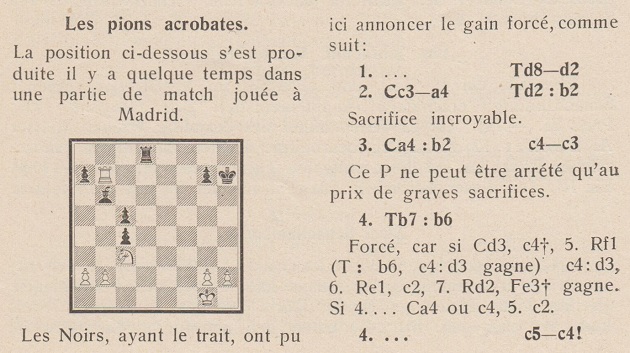
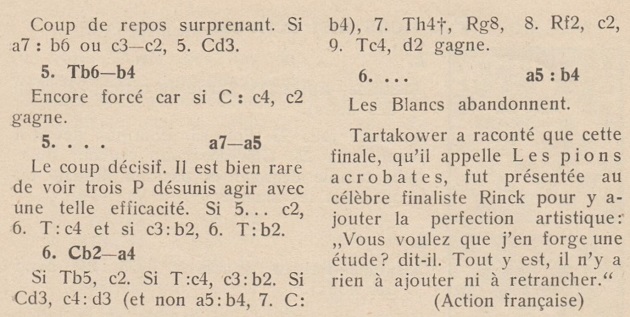
11234. A dog fight (C.N. 11201)
Leonard Barden (London) writes:
‘My game against John Littlewood at Hastings, 1961-62 was traumatic for me. For once I got my preparation spot on, had that morning revisited Larsen v Panno, Mar del Plata, 1958, and was stunned when Littlewood, finding it all slowly at the board, reached the identical position after 23 moves before varying with 24 Rhe1. I had taken around five minutes to his one hour, and assumed that I was winning.
Expecting to find a mate with his king at c4, I in turn thought for too long and lost my objectivity. I feel that I was fated in that tournament since I also missed a forced draw against Botvinnik.’
11235. The origins
Our latest feature article is The Origins of Chess.
11236. Alekhine and the 1936 Olympiad in Munich
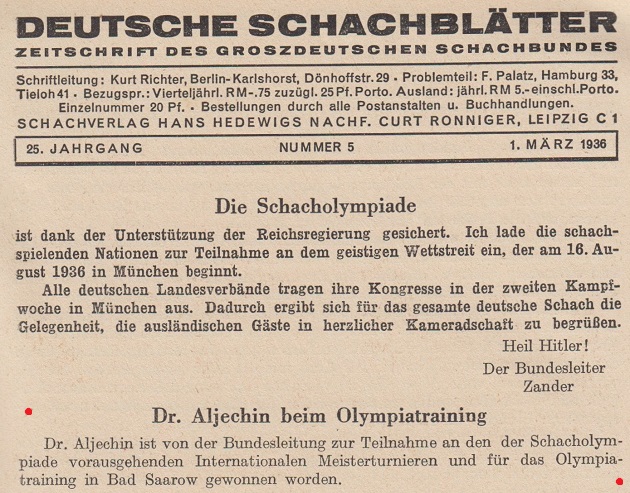
Page 65 of Deutsche Schachblätter, 1 March 1936
Another snippet, from page 38 of the March 1936 Schweizerische Schachzeitung:

Of course, no international tournament was held in Wiesbaden. For further information about Alekhine’s involvement in the training programme for German participants in the 1936 Olympiad, see page 560 of the Skinner/Verhoeven monograph on him.
The former world champion did not play in the Olympiad, but his country, France, did. It came second from bottom out of 21 teams.
11237. Living chess at Kalamazoo
From page 154 of the September-October 1927 American Chess Bulletin:
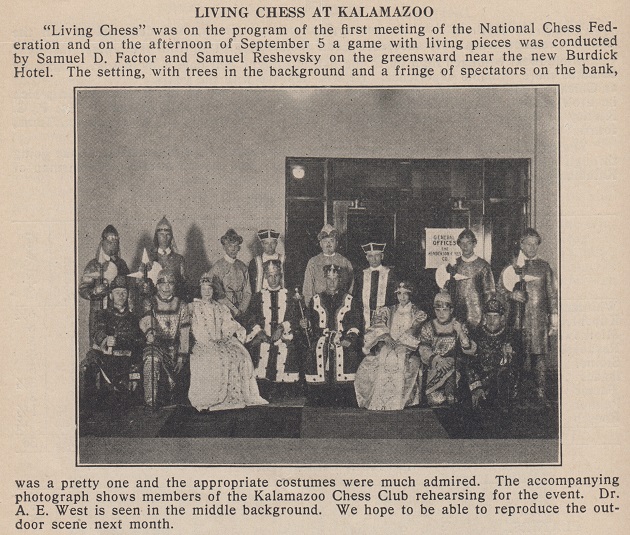
A group photograph of the Kalamazoo, 1927 tournament was given in C.N. 4782.
11238. Who?

11239. Lasker and psychology
Much has been written about Emanuel Lasker and psychology at the chess board; see, for instance, pages 3-25 of Winning with Chess Psychology by Pal Benko and Burt Hochberg (New York, 1991). Réti’s observations on Lasker in Masters of the Chess Board are well known, but when did public discussion begin of Lasker’s ‘psychological’ approach to the game?
Alekhine made some notable comments about chess psychology, including a reference to Lasker, on page 150 of his book Das New Yorker Schachturnier 1927 (Berlin, 1928):

11240. Unfulfilled hopes
From page 75 of the February 1938 BCM:
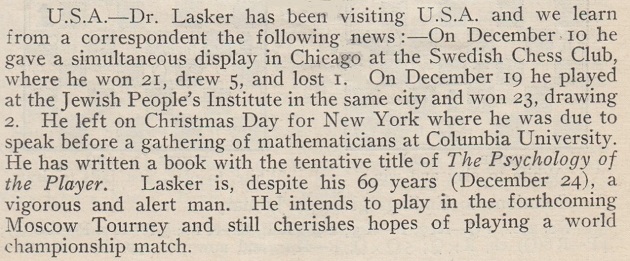
The ‘forthcoming Moscow Tourney’ had been mentioned on page 23 of the January 1938 issue in the section on news from Russia:
‘A grand master tournament is being planned to take place here in February. Amongst those invited will be Euwe, Lasker, Capablanca and even Alekhine.’
11241. An interview with Emanuel Lasker
This interview was published on page 5 of the El Paso Times, 29 March 1926:

11242. A three-mover by Valentín Marín
ChessBase has recently been discussing a difficult three-move problem by Valentín Marín, and below we show its appearance on page 168 of the April 1905 BCM:
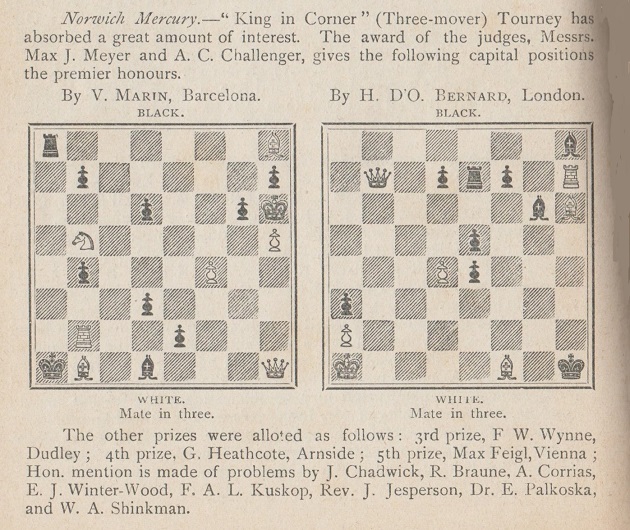
Page 290 of the July 1905 issue reported that four readers had solved Marín’s problem: J. Stillingfleet Johnson, J.D. Tucker, G. Browne and E.W. Brook. Only two readers were named for solving the composition by H.D’O. Bernard: G. Stillingfleet Johnson and C. Johnston.
| First column | << previous | Archives [175] | next >> | Current column |
Copyright: Edward Winter. All rights reserved.
